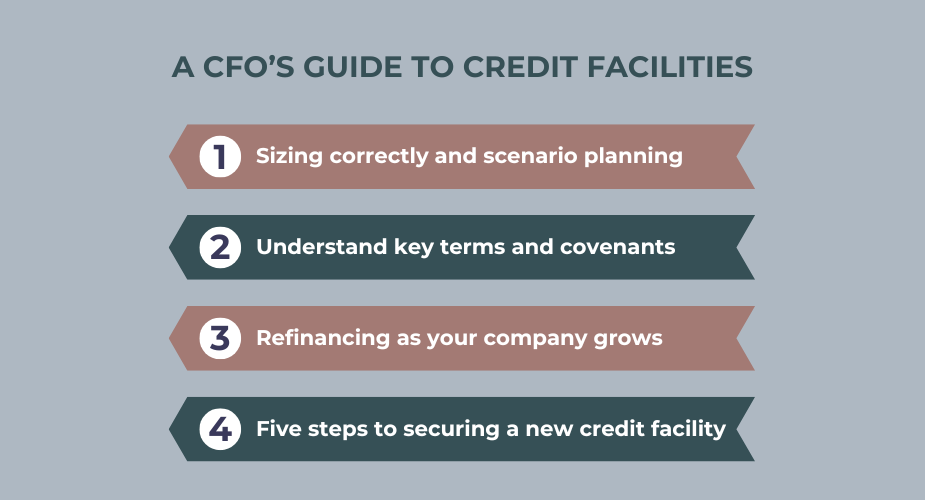Corporate Debt Refinancing 101: Why and How Companies Refinance Their Debt
Refinancing corporate debt is a strategic process that companies use to optimize their capital structure, reduce interest expense, or extend their debt repayment period. A combination of factors may influence the refinancing decision, particularly during environments with high interest rates.
Corporate debt refinancing allows a company to replace an existing debt obligation, such as a revolving credit facility or term loan, with new debt under more favorable terms. The new terms may be at a lower interest rate, give the company access to additional working capital to build new facilities, extend the maturity date for repayment, or simply provide a better fit to the company's growth profile.
What is Debt Refinancing?
Corporate debt refinancing is when a company restructures or replaces its existing debt with new debt, typically to take advantage of better borrowing terms. Companies refinance their debt to reduce interest costs, extend the maturity of the debt, or adjust the terms of their loans to improve their financial stability.
The Benefits of Refinancing Debt
Companies pursue corporate debt refinancing for several reasons. Three common motivators include:
Reducing Interest Expense
One of the most common motivators is the opportunity to reduce interest expense by refinancing existing high-interest corporate debt with lower-interest debt, thereby reducing a company’s interest expense. Reducing interest expense will increase a company’s operating cash flow, which can be redirected toward other corporate or growth initiatives.
Extending the Maturity Date
Another reason for refinancing is to extend the repayment period of existing corporate debt. Many credit facilities are structured such that when companies borrow money, they pay the lender interest on the amount borrowed, but don’t repay the principal borrowed until the maturity date.
By refinancing, the maturity date of the loan is extended and businesses can continue with interest payments without having the pressure of repaying the entire principal amount. This strategy is particularly beneficial during periods of economic downturn or contracted growth or when future revenue is uncertain, as it provides more flexibility in retaining and managing cash flow.
As an example, consider a company who has established a $100 million 5-year revolving credit facility at SOFR + 200bps*. They have an average utilization of 75% and the SOFR rate has been steady at 5.35%.
The company’s current interest rate on any funds borrowed is 7.35% (SOFR @ 5.35% + 200bps)
With credit facility utilization of 75%, the company has borrowed $75 million
Quarterly interest payments are ~ $1.38 million
At the maturity date, the company will be obligated to repay the entire outstanding $75 million
As shown in the above example, the cash flow requirement to repay the borrowed $75 million is significant. In contrast, the $1.38 million in quarterly interest payments can be more easily managed from operational cash flow. If the company chooses to refinance their corporate debt, it will extend the maturity date, thereby extending the length of time necessary to repay the full $75 million borrowed.
Amending the Rate Structure
Refinancing can also be used to adjust the structure of debt from variable-rate to fixed-rate loans or vice versa. In periods of rising interest rates, locking in a fixed-rate loan allows companies to insulate themselves from having to absorb the cost of future interest-rate increases. Fixed-rate debt offers interest expense predictability, which can help with cash flow management. Alternatively, companies may do the opposite and adjust the structure of their debt from fixed-rate to variable-rate, which they may be inclined to do during periods of falling interest rates to reduce their cost of borrowing in the future.
Refinancing vs. Restructuring
As part of this discussion, it’s important to distinguish between refinancing and restructuring. While the latter likely includes the former, debt refinancing and debt restructuring are separate strategies that serve different purposes. They are generally utilized under a different set of circumstances.
Refinancing is often opportunistic. A company in a position of financial strength, either due to strong economic conditions or an improved growth profile, may wish to negotiate more favorable terms with their lenders or increase their borrowing capacity.
Alternatively, restructuring is often pursued when a company is in financial distress, or will be in the near future. During restructuring, companies negotiate with their existing lenders to avoid a breach in financial covenants or to avoid credit default. Debt restructuring may employ the same tactics as refinancing as listed above, but lenders will have the ability to exert greater control over what they can demand from companies. Commonly referred to as “amend and extend,” lenders may agree to amend an existing credit agreement or extend the maturity date to avoid default, but at terms that are increasingly costly for the company.
Current Corporate Debt Market
Source: SIFMA Research
The corporate debt market is always changing and understanding historical and current levels of debt issuance, lender risk tolerance, and the cost of borrowing are important when considering the optimal timing to refinance.
In the past five years, corporate debt levels rose substantially. Fueled by low interest rates and a need for increased liquidity during the Covid pandemic, many companies opportunistically issued debt to increase their cash reserves. However, more recently, in an effort to combat inflation, the Federal Reserve has been raising benchmark interest rates and the cost of corporate debt has increased sharply.
Companies who issued corporate debt in 2020 with a 5-year maturity date will likely need to refinance in the next twelve to fifteen months under a very different interest rate environment. Some companies have chosen to refinance proactively, which could increase their overall cost of debt, but they will also potentially secure more favorable long-term lending terms before their loan matures.
Do a Market Assessment of the Lending Environment
Companies should not wait until their debt matures to assess the market and weigh their options. Cyclicality in lending preferences and the uncertainty of the macroeconomic and interest rate environments may make it opportunistic to refinance existing debt before your company is faced with limited options or a large balloon principal payment.
Consider Working with a Financial Advisor when Refinancing
Navigating the refinancing process can be challenging, but having a skilled financial advisor can make a critical difference in the outcome for several reasons:
Fostering Competition: A financial advisor can create a competitive process among lenders who are vying to win your business. Working with multiple potential lenders not only gives you greater transparency into market pricing, but competition can ultimately drive down your cost of borrowing and increase your negotiating leverage.
Assisting in Negotiations: Credit agreements are long and can be arduous to understand. An experienced financial advisor will be able to explain the business implications of all of the terms of the agreement and negotiate with lenders on behalf of your business.
Providing an Independent Perspective: Financial advisors can add value by offering an independent perspective on the company’s credit story, reviewing business plan assumptions, and assessing key financial metrics to strengthen the business’ refinancing options.
Streamlining Information: Before approaching potential lenders, your financial advisor can help organize financial and non-financial information, streamlining the process and ensuring information consistency.
Throughout the refinancing process, a financial advisor can utilize their expertise to facilitate the entire process alongside the company to ensuring a favorable outcome. If the company needs to form a syndicate of multiple lenders, the right financial advisor can help to arrange the syndicate on behalf of the company, saving additional time and expense.
Keene Advisors Insight Series: Corporate Debt Financing
Keene Advisors is experienced at advising companies on a broad range of corporate debt transactions and leveraged finance matters. Our team has advised clients in connection with over $20 billion of financing commitments and corporate debt capital raising transactions. We have helped clients fund organic growth, fund dividends to shareholders, buy out existing shareholders, fund acquisitions, and refinancing existing debt. In addition, our team has advised clients on credit agreement amendments, operational and balance sheet restructurings, and a range of bankruptcy related matters.
Contact us to determine the optimal amount of corporate debt for your business.
* SOFR is the Secured Overnight Financing Rate and serves as the reference borrowing rate for most variable-rate corporate debt. Lenders add a margin over the reference rate based on a company’s perceived credit risk. Mathematically, one basis point (bp) equals .0001. So in this example, 200 bps = .02 = 2.0% which is added to the SOFR rate to determine the company’s borrowing rate.
Disclaimer: This commentary is intended for general informational purposes only. Keene Advisors does not render or offer to render personalized financial, investment, tax, legal or accounting advice through this report. The information provided herein is not directed at any investor or category of investors and is provided solely as general information. No information contained herein should be regarded as a suggestion to engage in or refrain from any investment-related course of action. Keene Advisors does not provide securities related services or recommendations to retail investors. Nothing in this report should be construed as, and may not be used in connection with, an offer to sell, or a solicitation of an offer to buy or hold, an interest in any security or investment product.







